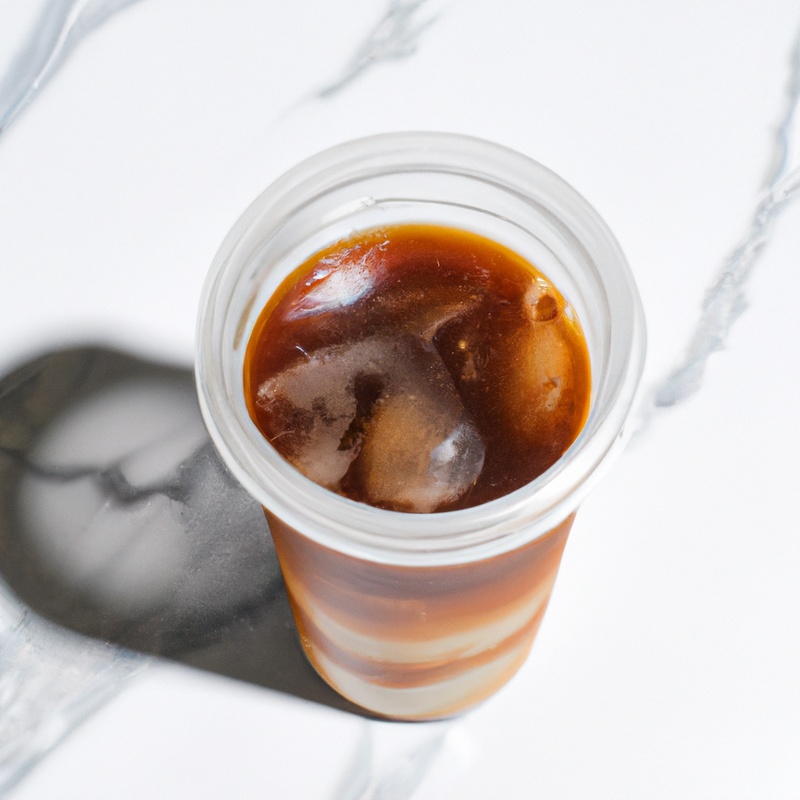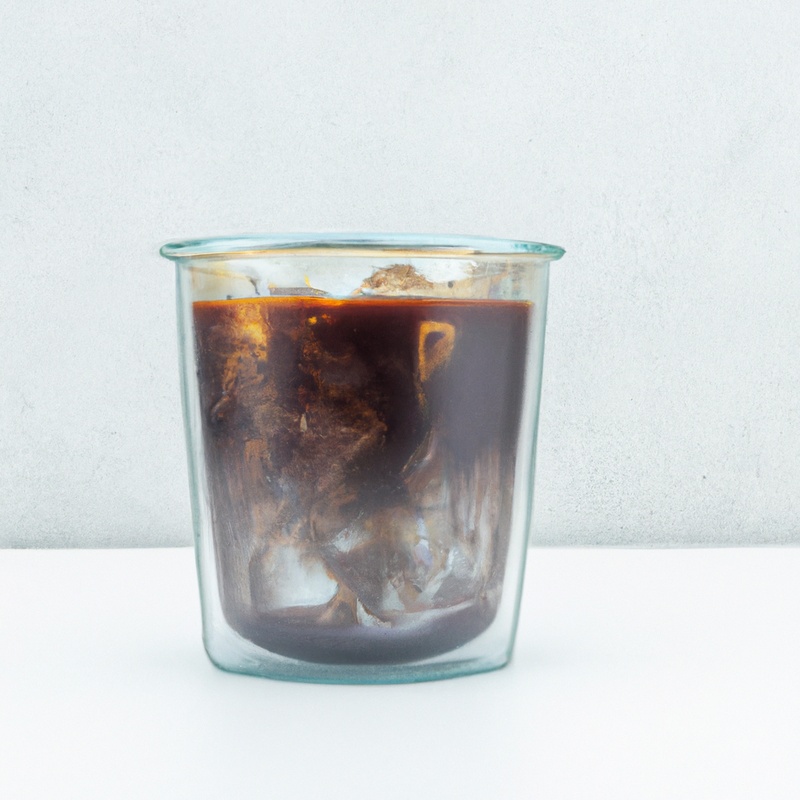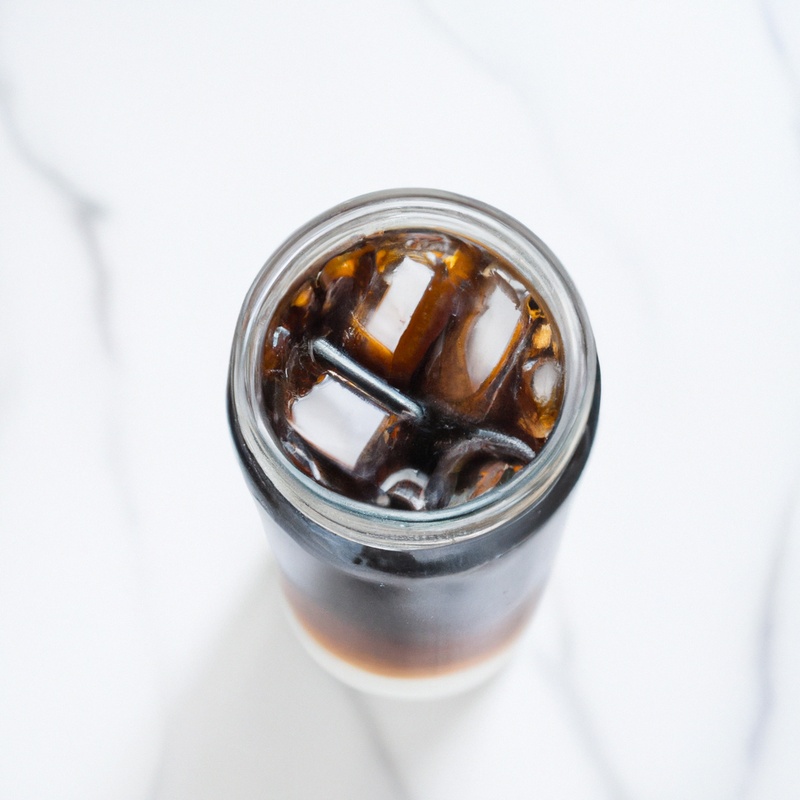Key Takeaways:
- Cold brew is made by steeping coffee grounds in cold water for an extended period, while iced coffee is brewed using hot water and then cooled down.
- Cold brew has a smoother and less acidic taste compared to iced coffee.
- Cold brew coffee is less likely to become diluted when ice is added, resulting in a stronger flavor.
- Cold brew coffee typically has a higher caffeine content than iced coffee.
Do you ever find yourself craving a refreshing cup of iced coffee on a scorching summer day?
Or perhaps you’re intrigued by the growing popularity of cold brew?
While both options deliver a chilled caffeine fix, there are key differences between cold brew and iced coffee that go beyond just their temperature.
In this article, we’ll dive into the distinct processes, taste profiles, caffeine content, serving styles, and more.
By the end, you’ll have a clear understanding of the contrasts between these two delicious summer beverages.
So, grab a chair and get ready to quench your thirst for knowledge!
| Cold Brew | Iced Coffee | |
|---|---|---|
| Brewing Method | Steeped in cold water for 12-24 hours | Brewed hot, then cooled and poured over ice |
| Flavor | Smooth, less acidic | Bolder, more acidic |
| Caffeine Content | Higher caffeine concentration | Slightly lower caffeine concentration |
| Serving Temperature | Served cold | Served cold or sometimes hot |
| Dilution | Undiluted, can be served straight | Often diluted due to ice melting |
| Serving Options | Served as is or mixed with milk, syrups, etc. | Served with or without milk, syrups, etc. |
| Preparation Time | Takes longer to prepare due to steeping time | Quicker to prepare as it’s brewed hot |
| Shelf Life | Can be stored in the refrigerator for 1-2 weeks | Best consumed immediately or within a day |
What is Cold Brew?
Cold brew is a coffee brewing method that involves steeping coffee grounds in cold or room temperature water for an extended period of time, typically 12-24 hours.
Definition and Process of Cold Brew
Cold brew is a method of making coffee by steeping coarsely ground coffee beans in cold water for an extended period of time, typically 12 to 24 hours.
The slow steeping process creates a unique flavor profile that is less acidic and smoother than traditional hot brewed coffee.
To make cold brew, you simply combine coffee and water in a container, let it sit at room temperature or in the refrigerator, and then filter out the grounds before serving over ice or diluting with water or milk.
It’s a refreshing way to enjoy coffee with less bitterness and a subtly sweet taste.

Benefits of Cold Brew
Cold brew offers several benefits compared to traditional iced coffee.
Firstly, it has a smoother, less acidic flavor.
This makes it easier on your stomach and teeth.
Secondly, the slower brewing process brings out the natural flavors of the coffee beans, resulting in a more robust taste.
Thirdly, cold brew tends to have a higher caffeine content, providing a stronger energy boost.
Additionally, it stays fresh for longer periods, so you can enjoy it throughout the day without worrying about it losing its flavor.
Overall, cold brew is a refreshing and flavorful alternative to iced coffee.

What is Iced Coffee?
Iced coffee is a refreshing beverage made by pouring cold brewed coffee over ice.
Definition and Process of Iced Coffee
Iced coffee is a refreshing beverage made by brewing coffee and then cooling it down with ice. It’s a great option when you want a cool and energizing drink on a hot day.
The process typically involves brewing coffee using hot water, and adding ice cubes to cool it down.
You can customize your iced coffee by adding milk, cream, sugar, or flavored syrups. It’s a simple yet satisfying way to enjoy your favorite coffee in a chilled form.
Benefits of Iced Coffee
Iced coffee offers a refreshing way to enjoy your caffeine fix, especially during hot summer months.
Here are a few benefits of iced coffee:
- Cooling effect: Nothing beats the feeling of sipping on a cold drink on a scorching day. Iced coffee provides a much-needed cooling sensation, helping you feel refreshed and revitalized.
- Energy boost: Just like hot coffee, iced coffee can provide a quick pick-me-up. The caffeine content in coffee can enhance alertness and improve focus, keeping you productive throughout the day.
- Less acidity: Some people find that iced coffee is less acidic compared to its hot counterpart. This can be beneficial for individuals who experience acidity or stomach discomfort after drinking regular coffee.
- Versatility: Iced coffee is incredibly versatile. You can customize it with different flavors, syrups, and milk options to suit your taste preferences. Whether you enjoy a classic black iced coffee or a fancy iced caramel macchiato, the options are endless.
- Convenience: If you’re constantly on the go, iced coffee is an easy and convenient option. You can prepare it in advance and store it in your fridge, ready to grab and enjoy whenever you need a refreshing boost.
Remember, moderation is key.
While iced coffee offers its benefits, it’s important not to overconsume caffeine and to stay hydrated throughout the day.
Enjoy your iced coffee responsibly and savor every sip.

Differences in Brewing Method
Cold brew and iced coffee differ in their brewing methods.
Cold Brew Brewing Method
Cold Brew Brewing Method is a simple and slow process.
Coarse ground coffee is steeped in cold or room temperature water for an extended period, usually 12 to 24 hours.
This slow extraction process results in a smoother, less acidic and less bitter coffee concentrate.
After steeping, the coffee grounds are usually filtered out, leaving behind a concentrate that can be diluted with water or milk.
Cold brew can be enjoyed over ice or heated and is perfect for hot summer days or those who prefer less acidity in their coffee.
Iced Coffee Brewing Method
The brewing method for iced coffee involves brewing coffee at double strength and then pouring it over ice to cool it down quickly.
Here’s a step-by-step breakdown of the process:
- Start by selecting your preferred coffee beans and grinding them to a medium-coarse consistency.
- Measure out the appropriate amount of coffee grounds based on your desired strength. Typically, you’ll want to use about twice as much coffee as you would for hot coffee.
- Brew the coffee using a brewing method of your choice, such as a French press, pour-over, or drip coffee maker. Make sure to use room temperature or cold water for the brewing process.
- Once the coffee is brewed, let it sit for a few minutes to cool slightly.
- Fill a glass or pitcher with ice cubes and pour the brewed coffee over the ice.
- Stir gently to combine the coffee and ice.
- If desired, add milk, sweetener, or any other flavorings to enhance the taste.
- Enjoy your refreshing iced coffee!
Remember, the key to a good iced coffee is to brew it at double strength to compensate for the dilution that occurs when the ice melts.
Experiment with different brewing methods, coffee-to-water ratios, and flavor additions to find your perfect cup of iced coffee.
Differences in Taste
Cold Brew has a smoother, less acidic taste compared to Iced Coffee.
Iced Coffee has a bolder, brighter flavor due to its brewing method.
Cold Brew Taste Profile
Cold brew has a distinct taste profile that sets it apart from other coffee brewing methods. It is known for its smoother, less acidic flavor compared to traditional hot brewed coffee.
The slow extraction process of cold brew results in a sweeter, more concentrated flavor profile with fewer bitter notes.
Cold brew also tends to have a deeper, more intense flavor that can be enjoyed both black and with added milk or sweeteners. Its smoothness and rich taste make it a popular choice for coffee lovers seeking a refreshing and flavorful alternative to hot coffee.
Iced Coffee Taste Profile
Iced coffee has a distinct taste profile that sets it apart from hot brewed coffee.
Its flavor is often milder and less acidic, with a smoother and less bitter finish.
The ice cubes and dilution of flavors can also affect the taste, making it slightly sweeter or more watery.
Additionally, the use of milk or cream in iced coffee can add a creamy and smooth texture, enhancing the overall taste experience.
Ultimately, the taste of iced coffee can vary depending on the brewing method, coffee beans, and added ingredients.
Differences in Caffeine Content
Cold brew typically has a higher caffeine content than iced coffee.
Cold Brew Caffeine Content
Cold brew coffee typically has less caffeine than regular hot coffee or iced coffee. This is because the extraction process used in cold brewing results in a lower caffeine content.
On average, an 8-ounce cup of cold brew contains around 100-200 milligrams of caffeine, whereas the same size cup of regular hot coffee can contain anywhere from 95-200 milligrams of caffeine.
So, if you’re looking for a coffee with a slightly lower caffeine kick, cold brew might be the way to go!
Iced Coffee Caffeine Content
Iced coffee typically has a higher caffeine content than regular hot brewed coffee. The caffeine content of iced coffee can vary depending on the brewing method and the ratio of coffee to water used.
On average, an 8-ounce serving of iced coffee contains around 95 milligrams of caffeine.
However, it’s important to note that this can vary widely depending on the specific type and brand of coffee used. So, if you’re looking for a caffeine boost, iced coffee might be your go-to beverage.
Serving Styles and Variations
Cold Brew Serving Styles and Variations: Explore unique variations such as flavored syrups, milk alternatives, or even adding a splash of soda for a refreshing twist.
Iced Coffee Serving Styles and Variations: Discover popular styles like Vietnamese iced coffee or Japanese-style iced coffee, and play with different sweeteners or toppings to personalize your brew.
Cold Brew Serving Styles and Variations
There are several popular serving styles and variations for cold brew coffee.
One common way to serve cold brew is over ice, which is a refreshing and simple option.
Another popular style is to add milk or cream to create a creamy and smooth drink.
Some people also like to sweeten their cold brew with sugar, honey, or flavored syrups for added taste.
Don’t forget about the option to experiment with different flavors by adding spices, extracts, or even a splash of your favorite spirit.
Personalize it to your taste!
Iced Coffee Serving Styles and Variations
Iced coffee comes in various serving styles and variations, allowing you to customize your drink according to your preferences.
Here are some popular options:
- Traditional Iced Coffee: This is the classic way of enjoying iced coffee, where freshly brewed hot coffee is poured over ice. It’s simple, refreshing, and perfect for those who prefer a strong and bold flavor.
- Iced Latte: A popular variation, an iced latte is made by combining espresso shots with cold milk and ice. It offers a creamy and smooth taste, making it a great choice for those who enjoy a milder and lighter coffee flavor.
- Iced Mocha: If you have a sweet tooth, you might enjoy an iced mocha. It incorporates chocolate syrup or powder into an iced latte, creating a delightful blend of coffee and chocolate flavors.
- Frappé: This frosty treat is made by blending ice, milk, coffee, and sweetener (like sugar or flavored syrup to create a thick and creamy beverage. It’s a popular choice for those who prefer a sweeter and more indulgent iced coffee experience.
- Cold Brew: Unlike the other variations, cold brew is made by steeping coarsely ground coffee in cold water for an extended period (typically 12-24 hours. The result is a smooth and less acidic drink, perfect for those who appreciate a less intense coffee flavor.
Remember, you can always experiment with different serving styles and variations to find the perfect iced coffee that suits your taste buds.
Whether you prefer it strong, creamy, or sweet, there’s an iced coffee variation out there for you to enjoy.
Temperature and Dilution
Cold Brew Temperature and Dilution: Cold brew is brewed with cold or room temperature water, resulting in a lower temperature compared to hot brewed coffee, and it is usually concentrated and requires dilution with water or milk. Iced Coffee Temperature and Dilution: Iced coffee is brewed with hot water, but then chilled or poured over ice, making it cooler than regular hot coffee, and it does not require dilution as it is ready to drink.
Cold Brew Temperature and Dilution
When it comes to cold brew coffee, temperature and dilution play key roles in the final taste.
The brewing process involves steeping coffee grounds in cold water for an extended period, usually around 12-24 hours.
This slow extraction method results in a smooth, low-acidity brew with less bitterness.
Temperature-wise, cold brew is brewed using cold water or water at room temperature, whereas iced coffee is made by brewing hot coffee and then cooling it with ice.
As for dilution, cold brew is typically mixed with water or milk to adjust the concentration, while iced coffee is diluted with the melting ice.
By understanding the temperature and dilution differences, you can choose which coffee suits your taste preferences and enjoy the refreshing flavors of either cold brew or iced coffee.
Iced Coffee Temperature and Dilution
Iced coffee temperature and dilution play important roles in enhancing your coffee experience. The temperature of your iced coffee should be cold, but not diluted.
To achieve this, brew your coffee at double strength and allow it to cool before pouring it over ice.
Diluting with ice alone will result in a weaker and watery-tasting coffee. Remember to experiment and find the perfect balance for your taste preferences.
Frequently Asked Questions
Can I use cold brew in place of iced coffee in recipes?
Yes, you can absolutely use cold brew in place of iced coffee in recipes! Cold brew is actually a great substitute for iced coffee because it has a smoother and less acidic flavor.
Whether you’re making a refreshing iced coffee drink, adding it to a dessert recipe, or using it as a base for a cocktail, cold brew can bring a delicious twist to your creations.
Just remember to adjust the measurements accordingly to achieve the desired taste.
Can I make cold brew or iced coffee at home?
Sure, you can definitely make cold brew or iced coffee at home! Here’s how you can do it:
- For cold brew coffee, simply combine coarsely ground coffee beans with cold water in a jar or pitcher. Let it steep in the fridge for around 12-24 hours. Then, strain the mixture to remove the grounds and enjoy your smooth, low-acid cold brew.
- To make iced coffee, brew your coffee using hot water as you normally would and then let it cool. Add ice cubes to a glass and pour the cooled coffee over them. You can sweeten or add milk as desired.
Remember, with both methods, you can experiment with the coffee-to-water ratio, brewing time, and additional flavors to find your preferred taste.
Have fun making your own cold brew or iced coffee at home!
Which is better for hot weather: cold brew or iced coffee?
For hot weather, hands down, the better option is iced coffee.
Here’s why: Iced coffee is brewed hot and then chilled, giving it a more robust flavor.
It’s also typically served with ice, making it instantly refreshing.
On the other hand, cold brew is made by steeping ground coffee in cold water for a longer period, resulting in a smoother, less acidic taste.
While both are great, iced coffee is the go-to choice to help you beat the heat.
Does cold brew or iced coffee have more calories?
Cold brew typically has fewer calories than iced coffee because it is made by steeping coffee grounds in cold water for a longer period of time, resulting in a smoother and less acidic flavor.
This slow extraction process extracts fewer oils and caffeine, which means it has fewer calories.
However, the total number of calories can vary depending on the type and amount of sweeteners or creamers added to the drink.
Final Verdict
Cold brew and iced coffee are two distinct beverages with unique characteristics. Cold brew undergoes a slow brewing process, resulting in a smooth and less acidic flavor profile.
On the other hand, iced coffee is brewed hot and then cooled down with ice, retaining more of the traditional coffee taste.
The caffeine content also varies, with cold brew typically having higher levels. Ultimately, the choice between cold brew and iced coffee comes down to personal preference, serving styles, and the desired level of caffeine.
So go ahead, explore these delightful coffee options and find your perfect summer companion.
